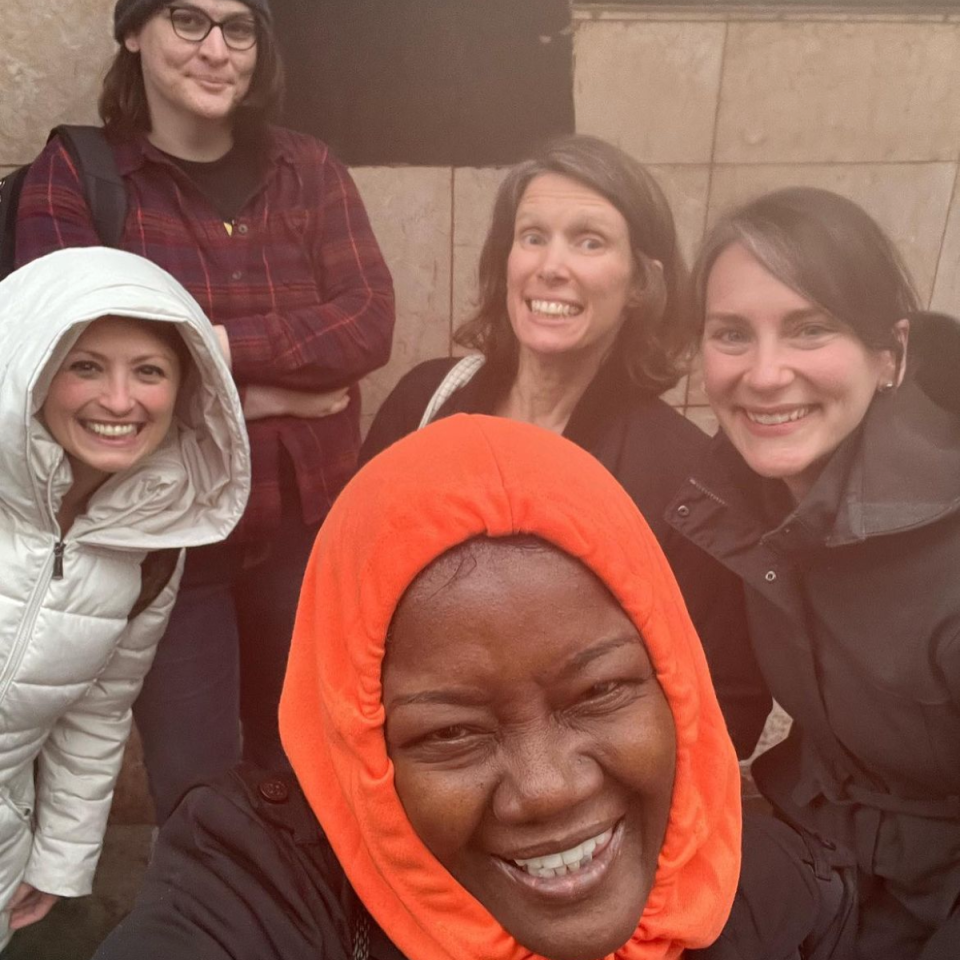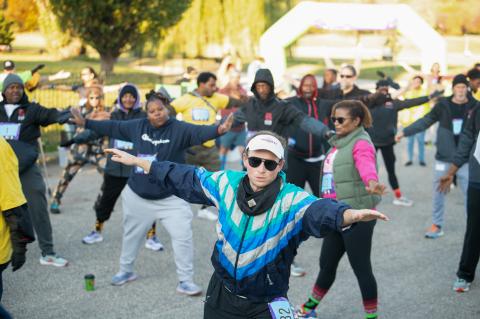
What does overdose prevention look like in practice?
OnPoint NYC is one of the first organizations in the country to launch Overdose Prevention Sites. People can consume pre-approved substances while under professional supervision at these facilities. Senior Peer Recovery Specialist Vicky Stewart, CPRS and Registered Nurse Kathy Pretl, RN (pictured front and center respectively) traveled three hours north with the rest of the Medication Assisted Treatment (MAT) team at Health Care for the Homeless to see a safe consumption site in action.
Why was it important to you to visit OnPoint and how does that connect with your day-to-day role?
Kathy: Every day I talk to people about what drugs they are using and what they can be doing to be safer. Through the MAT program, we offer access to suboxone and safer use supplies and resources. I’m really committed to harm reduction and dignity for clients who use drugs, and overdose prevention sites are the most far-reaching resource – and statement of respect - that I’m aware of. I wanted to see what it would look like in practice.
Vicky: As an individual with lived experience with substance use, my goal is to meet people where they are and keep them from going to the ER. I assist with referrals to dentists, to suboxone or methadone, bus tokens, IDs, clean needles—really anything to help someone maintain the healthiest lifestyle possible. I heard a lot about overdose prevention sites over the years, but none as close as New York City. I was curious. OPS is another tool in the toolbox.
What were your first impressions?
Vicky: When we got there, I realized I was in the middle of Harlem. I think I was expecting an after-hours tour, but everything was in motion. People were coming in to get their mail, get a shower, take a nap and get acupuncture. Then we went into the section where they inject drugs. For me, as a person in long-term recovery, it was a little uncomfortable to be in there while they were in the process of injecting drugs. I had a lot of questions. How does the monitoring go? What kind of experience do you need to do this job? What happens when someone says, “I want to go to treatment?”
Kathy: Like Vicky said, there was so much going on! It is very New York! They have food, laundry services, a quiet room with cots, massage and reiki room—and the supervised consumption was a small piece of it. That area looks like a clinical space and interactions of staff and clients felt very familiar and homey like we do with MAT clients here.
What was your biggest take-away from the visit?
Kathy: They haven’t had any fatal overdoses. The nurses on the trip, including me, were most struck by how OnPoint manages overdoses by using small amounts of Narcan and rescue breathing. Normally, people go through rapid withdrawal with Narcan and wake up fighting because they feel terrible. This visit introduced the idea that we shouldn’t add another unpleasant interaction with the medical establishment and to consider ways to come out of an overdose more gently. That has directly influenced how we think about overdose response at Health Care for the Homeless, too.
Vicky: I talked to a few neighbors about the program. One guy asked, “Why come in my neighborhood and bring this program that will bring more illegal activity? Why in a residential neighborhood?” I told him, “They’re not dying on 5th Avenue. People like me and you are the ones that are dying. What better place than the neighborhood where it’s needed?”
It’s not perfect, and I want to make sure that if someone’s desire to inject drugs changes, that they can address that on the spot and offer treatment. But it’s a great start to be in a safe environment and know that you’re supported. You can’t force nobody to do anything, but if you can keep them as healthy as possible in this process it’s a win-win.
What do you think it will take to approve Overdose Prevention Sites in Maryland?
Vicky: When we’re talking about saving lives of people of color or people period, residents have been ready. But the people who run things in Annapolis aren’t ready. Maybe in 30 years, after 20 million of us die. The only thing we’re missing is the open-mindedness in the city. We went through that with the syringe program back in the day. That wasn’t funded until they saw a reduction in HIV cases. We’re giving out syringes and wound care – all we need is a building. If someone is there and watching you, they can save your life. I know this from experience.
Kathy: I also fear that continuing to have large amounts of overdose deaths will push us there from a political standpoint. A safe place for people to use drugs is hard for people to imagine, even those who want to see better outcomes for people with substance use disorder. But it’s not that spooky—it’s like a community center. It was a friendly place that wanted to see people walk away from using drugs alive and well.
Fast Facts from OnPointNYC
Overdose Prevention Sites primarily:
- prevent overdose death and other health risks associated with drug use
- facilitate connection to care
- reduce public drug use and hazardous waste in public spaces
- So far, OnPoint has saved more than 1,000 lives
Despite community concern about crime, a study on the impact of OnPoint found:
- No significant increase in crime
- 83% decrease in low-level drug-related arrests
- 57% fewer arrests for weapon possession
Learn more at onpointnyc.org
More Recent News
At our annual staff holiday party, we take time to recognize and celebrate staff members who best represent our Core Values, as well as one recipient of the Von Bradshaw Award, named after Delvonia "Von" Bradshaw, who passed away in 2024 and truly held the principles of Health Care for the Homeless to heart. Please congratulate your colleagues when you see them!
Those of us in the Health Care for the Homeless community share a belief in something powerful: that everyone should have a place to call home.
Hope for that vision isn’t passive. It’s something that clients, staff and community supporters make possible together.
With SNAP benefits in Maryland facing uncertainty, many families are wondering how they’ll put food on the table. Here are ways Health Care for the Homeless is helping, as well as a list of local food assistance resources.
On Saturday, November 1, more than 300 runners, walkers, friends and volunteers gathered in Patterson Park for the 2025 Rock Your Socks 5K. Read all about this year's awesome event!




